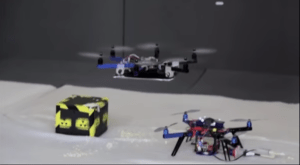A British researcher has combined two emerging technologies that could revolutionize the removal of hazardous waste.
Mirko Kovac of the Imperial College of London is leading a team that uses a tag-team approach to waste management by deploying two drones – a quadcopter paired with a 3D printer and a hexacopter capable of lifting up to 5.5 pounds.
Rowan Hooper of New Scientist explains:
The quadcopter carries two chemicals which create polyurethane foam when mixed, and a printing module to extrude the foam. [The quadcopter] hovers over a box … before squirting the foam on to the box … The hexacopter now lands on the foam and, after … the foam sets hard, it takes off again, carrying the box with it.
This kind of one-two drone punch could make the process of removing nuclear waste from a scene much safer. In addition, the drone duo, which works almost autonomously, could be used for “ad-hoc construction of first response structures in search-and-rescue scenarios,” and “printing structures to bridge gaps in discontinuous terrain,” according to the research team’s statement of purpose.
The project is attempting to develop drones that can operate in much the same way as organisms in the natural world – the case of the drones, mimicking a bird that builds nests using its own saliva.
“This is an exciting first step in the lab’s development of co-operative robotic systems for building structures inspired by the natural world,” Natural History Museum ecologist Thomas Creedy said in a media statement.
“The aim is that these systems will enable a wide range of robotic applications, in particular extending the operating scope of scientific survey robots in challenging environments such as rainforests through the adaptable construction of recharging platforms or monitoring stations,” he added.
According to an Imperial College press release, the team hopes to make the drones completely autonomous.
“The next step for the team is to enable the vehicle to fly autonomously in any environment. They plan to incorporate high-speed cameras and sensors on board the [drone], which will act like a satellite navigation system for tracking and controlling of the flight trajectory.”
Check out the project in action:
Jason is a longstanding contributor to DroneLife with an avid interest in all things tech. He focuses on anti-drone technologies and the public safety sector; police, fire, and search and rescue.
Beginning his career as a journalist in 1996, Jason has since written and edited thousands of engaging news articles, blog posts, press releases and online content.
Email Jason
TWITTER:@JasonPReagan
Subscribe to DroneLife here.
